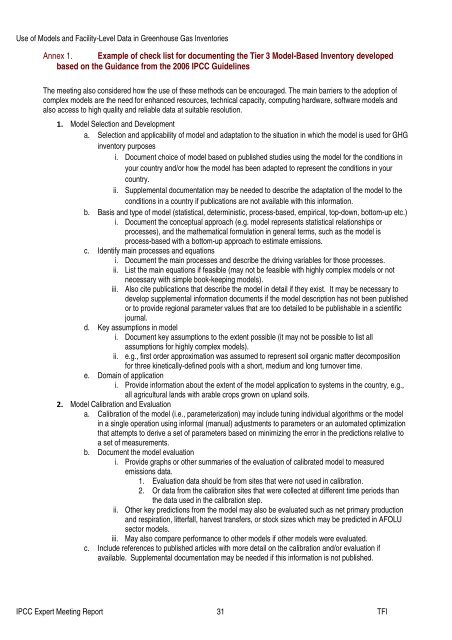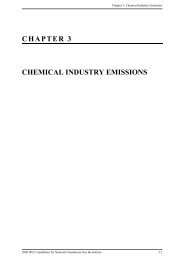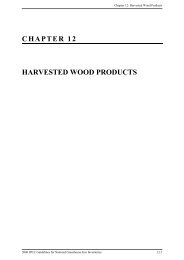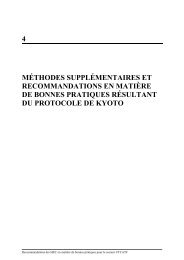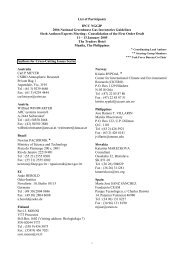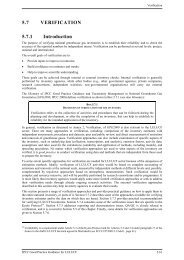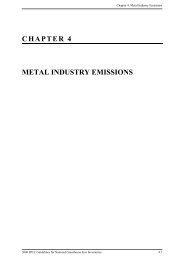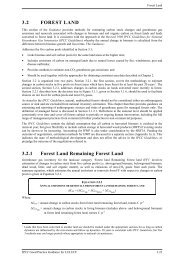Use of Models and Facility-Level Data in Greenhouse Gas Inventories
Use of Models and Facility-Level Data in Greenhouse Gas Inventories
Use of Models and Facility-Level Data in Greenhouse Gas Inventories
Create successful ePaper yourself
Turn your PDF publications into a flip-book with our unique Google optimized e-Paper software.
<strong>Use</strong> <strong>of</strong> <strong>Models</strong> <strong>and</strong> <strong>Facility</strong>-<strong>Level</strong> <strong>Data</strong> <strong>in</strong> <strong>Greenhouse</strong> <strong>Gas</strong> <strong>Inventories</strong><br />
Annex 1. Example <strong>of</strong> check list for document<strong>in</strong>g the Tier 3 Model-Based Inventory developed<br />
based on the Guidance from the 2006 IPCC Guidel<strong>in</strong>es<br />
The meet<strong>in</strong>g also considered how the use <strong>of</strong> these methods can be encouraged. The ma<strong>in</strong> barriers to the adoption <strong>of</strong><br />
complex models are the need for enhanced resources, technical capacity, comput<strong>in</strong>g hardware, s<strong>of</strong>tware models <strong>and</strong><br />
also access to high quality <strong>and</strong> reliable data at suitable resolution.<br />
1. Model Selection <strong>and</strong> Development<br />
a. Selection <strong>and</strong> applicability <strong>of</strong> model <strong>and</strong> adaptation to the situation <strong>in</strong> which the model is used for GHG<br />
<strong>in</strong>ventory purposes<br />
i. Document choice <strong>of</strong> model based on published studies us<strong>in</strong>g the model for the conditions <strong>in</strong><br />
your country <strong>and</strong>/or how the model has been adapted to represent the conditions <strong>in</strong> your<br />
country.<br />
ii. Supplemental documentation may be needed to describe the adaptation <strong>of</strong> the model to the<br />
conditions <strong>in</strong> a country if publications are not available with this <strong>in</strong>formation.<br />
b. Basis <strong>and</strong> type <strong>of</strong> model (statistical, determ<strong>in</strong>istic, process-based, empirical, top-down, bottom-up etc.)<br />
i. Document the conceptual approach (e.g. model represents statistical relationships or<br />
processes), <strong>and</strong> the mathematical formulation <strong>in</strong> general terms, such as the model is<br />
process-based with a bottom-up approach to estimate emissions.<br />
c. Identify ma<strong>in</strong> processes <strong>and</strong> equations<br />
i. Document the ma<strong>in</strong> processes <strong>and</strong> describe the driv<strong>in</strong>g variables for those processes.<br />
ii. List the ma<strong>in</strong> equations if feasible (may not be feasible with highly complex models or not<br />
necessary with simple book-keep<strong>in</strong>g models).<br />
iii. Also cite publications that describe the model <strong>in</strong> detail if they exist. It may be necessary to<br />
develop supplemental <strong>in</strong>formation documents if the model description has not been published<br />
or to provide regional parameter values that are too detailed to be publishable <strong>in</strong> a scientific<br />
journal.<br />
d. Key assumptions <strong>in</strong> model<br />
i. Document key assumptions to the extent possible (it may not be possible to list all<br />
assumptions for highly complex models).<br />
ii. e.g., first order approximation was assumed to represent soil organic matter decomposition<br />
for three k<strong>in</strong>etically-def<strong>in</strong>ed pools with a short, medium <strong>and</strong> long turnover time.<br />
e. Doma<strong>in</strong> <strong>of</strong> application<br />
i. Provide <strong>in</strong>formation about the extent <strong>of</strong> the model application to systems <strong>in</strong> the country, e.g.,<br />
all agricultural l<strong>and</strong>s with arable crops grown on upl<strong>and</strong> soils.<br />
2. Model Calibration <strong>and</strong> Evaluation<br />
a. Calibration <strong>of</strong> the model (i.e., parameterization) may <strong>in</strong>clude tun<strong>in</strong>g <strong>in</strong>dividual algorithms or the model<br />
<strong>in</strong> a s<strong>in</strong>gle operation us<strong>in</strong>g <strong>in</strong>formal (manual) adjustments to parameters or an automated optimization<br />
that attempts to derive a set <strong>of</strong> parameters based on m<strong>in</strong>imiz<strong>in</strong>g the error <strong>in</strong> the predictions relative to<br />
a set <strong>of</strong> measurements.<br />
b. Document the model evaluation<br />
i. Provide graphs or other summaries <strong>of</strong> the evaluation <strong>of</strong> calibrated model to measured<br />
emissions data.<br />
1. Evaluation data should be from sites that were not used <strong>in</strong> calibration.<br />
2. Or data from the calibration sites that were collected at different time periods than<br />
the data used <strong>in</strong> the calibration step.<br />
ii. Other key predictions from the model may also be evaluated such as net primary production<br />
<strong>and</strong> respiration, litterfall, harvest transfers, or stock sizes which may be predicted <strong>in</strong> AFOLU<br />
sector models.<br />
iii. May also compare performance to other models if other models were evaluated.<br />
c. Include references to published articles with more detail on the calibration <strong>and</strong>/or evaluation if<br />
available. Supplemental documentation may be needed if this <strong>in</strong>formation is not published.<br />
IPCC Expert Meet<strong>in</strong>g Report 31 TFI


